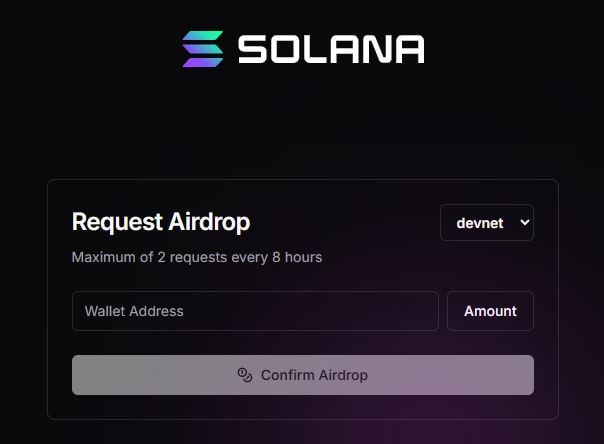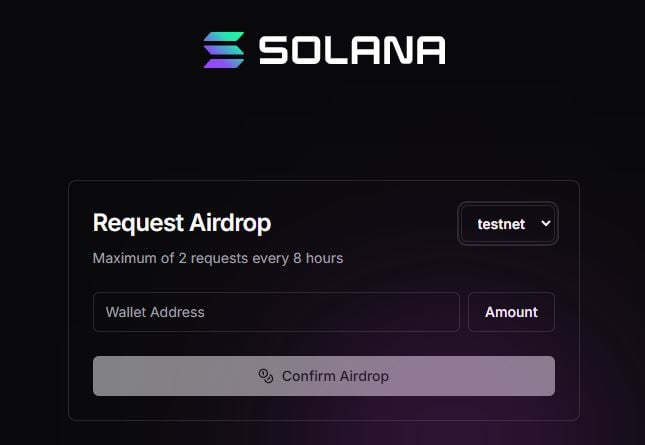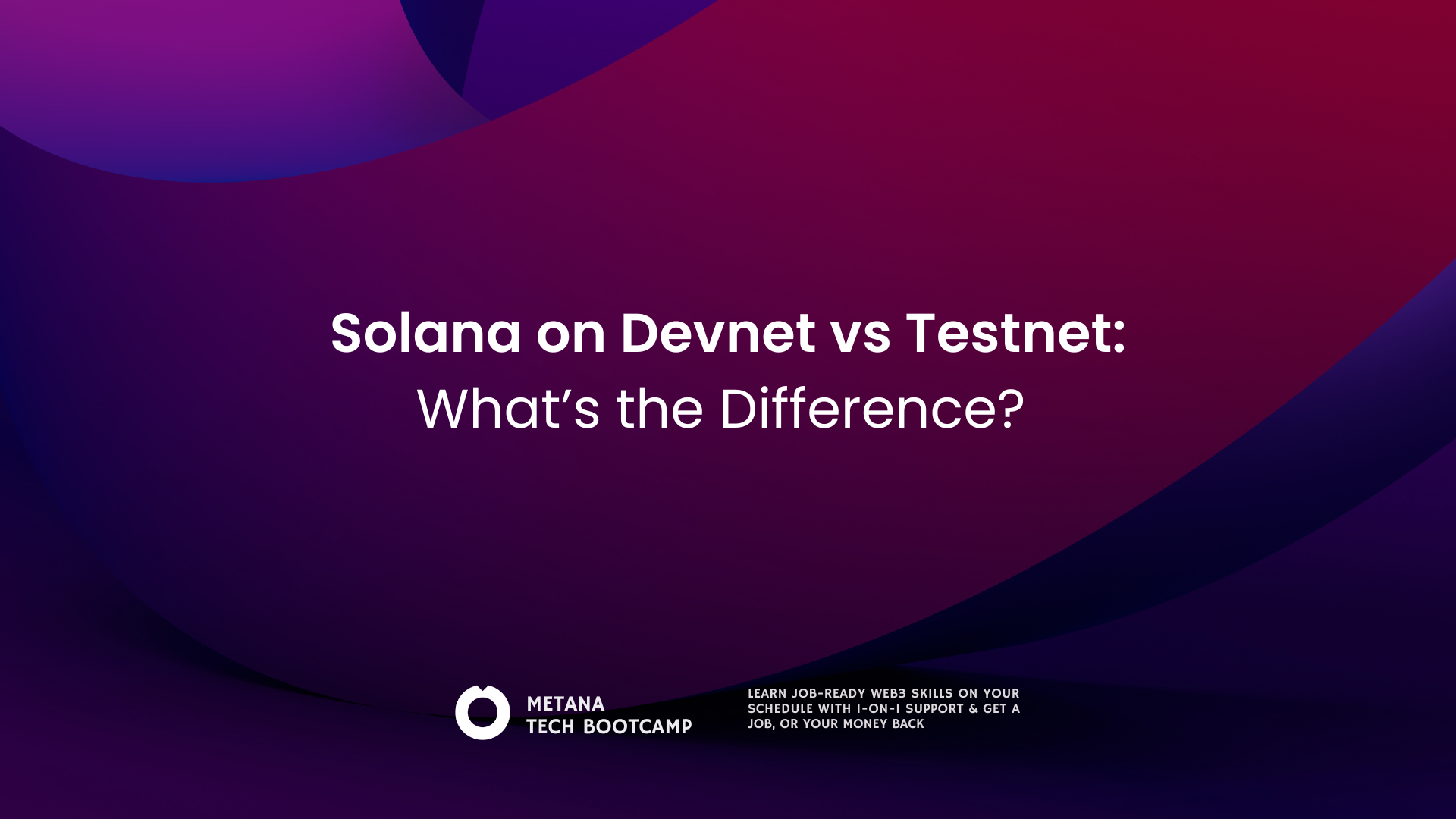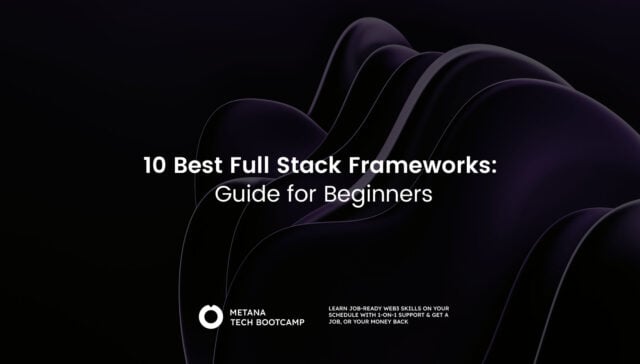TL; DR
- Solana faucet provides free SOL tokens for testing on Devnet and Testnet with no real-world value
- Devnet
- Best for early-stage development and experimentation
- Frequently resets to offer a fresh testing environment
- Tokens have no monetary value and cannot be transferred to the mainnet
- Ideal for debugging and testing basic features
- Testnet
- More stable and realistic than Devnet
- Simulates real-world network conditions for final-stage testing
- Suitable for stress-testing applications under higher traffic
- Tokens have no monetary value and cannot be transferred to the mainnet
- Mainnet is the real live network where actual transactions happen
- Choosing the Right Environment
- Use Devnet for early development and experimentation
- Use Testnet for final testing and performance validation before launching on the mainnet
- Accessing faucets for both Devnet and Testnet allows you to request free tokens for testing purposes
As blockchain technology continues to evolve, Solana has emerged as one of the most efficient and scalable platforms for decentralized applications. For developers looking to build on Solana, it’s crucial to understand the different testing environments available before launching on the mainnet. Among the most important test networks are Devnet and Testnet. Both offer developers the ability to test and debug their applications in a controlled, low-risk environment.
In this article, we will explore the Solana faucet and break down the key differences between Devnet and Testnet, two essential test environments on Solana.
What is a Faucet in Blockchain?
Faucet in simple terms, is a website or application that provides cryptocurrency tokens for free for their users. In no way you have to pay for these! This can include tasks such as completing captchas, playing a simple game or even watching an advertisement.
Thinking how to use these rewards? You can use these free tokens to:
- Learn web3
- Test smart contracts
- Debug transactions
You can utilize these crypto faucets to get familarized with crypto transactions and wallet operations. Taken from article: Crypto Faucet 101
What is the Solana Faucet?
The Solana faucet is a service that provides free SOL tokens for testing and development purposes on Solana’s Devnet and Testnet. These tokens are provided to developers, testers, and users so they can interact with the Solana blockchain in a non-production environment, simulating real-world conditions without using real, valuable SOL. Once testing is complete, these tokens are no longer transferable to the mainnet, meaning they are strictly for testing purposes.
Knowledge perks
What is a Mainnet?
The mainnet is the active, primary blockchain network that operates in real-time, supporting genuine transactions. It is where actual value is transferred.
Key Purposes: Allows users to send and receive cryptocurrency, deploy smart contracts, and engage with decentralized applications. Pulled from article: Mainnet and Testnet
Now that we understand a faucet and solana faucet, let’s explore the two key test environments available to developers: Devnet and Testnet
What is Solana Devnet
Devnet is ideally the first step for developers who want to build on the Solana blockchain. It serves as a testing environment that is specifically designed for early-stage development and experimentation.
Knowledge perks
How to choose your testing environment?
Whether you are deploying or testing your first mart contract your solidity IDE should provide you deployment support, debugging tools and a build-in-compiler. Taken from article: Best IDEs for Developers
Solana’s Devnet is open to all developers and provides a safe, risk-free space where they can test their applications without spending real tokens.
While Devnet closely mimics the mainnet in terms of features and functionality, the tokens used here hold no real monetary value. This makes Devnet ideal for testing out transactions, running applications, and debugging without the fear of losing valuable assets.
One major advantage of Devnet is that the network undergoes frequent resets. Since Devnet is designed for development and testing, the network is periodically reset to ensure that developers are always working with a fresh environment. This reset feature can cause temporary disruptions but ensures that developers do not have to worry about old data or previous configurations interfering with their testing process.
What Are The Key Features of Devnet?
- Free tokens are available through the Solana faucet, which allows developers to request SOL tokens to cover transaction costs and test their applications. These tokens are crucial for testing smart contracts, interacting with the network, and running decentralized applications (dApps).
- Devnet is open and accessible to anyone. This means developers from all over the world can freely join the network and start building applications. It’s the ideal platform for anyone who wants to explore Solana’s technology without facing financial barriers.
- Devnet is designed as a temporary environment and is frequently reset. This ensures that developers always work in a fresh space, but it also means data from previous tests can be erased, making it unsuitable for long-term or high-traffic simulations.
- The tokens used on Devnet have no real-world value and cannot be transferred to the mainnet. This eliminates the risk of financial loss during testing, allowing developers to experiment without hesitation.
When Should You Use Devnet?
Devnet is perfect for the initial phases of development. If you are just starting to build a decentralized application or need a safe environment to test new features, Devnet provides an easy, low-risk platform to get started. It is well-suited for debugging and experimenting with features. However, because Devnet is frequently reset, it is not suitable for long-term testing or for simulating high-traffic scenarios.
Interested in learning more about how to test your smart contracts? : Test your first smart contracts
What is Solana Testnet
Once your application has progressed beyond the initial development stages on Devnet, the next step is usually to move to Testnet.
Solana’s Testnet provides a more stable and realistic environment that simulates mainnet conditions. While Devnet is ideal for early-stage development, Testnet offers a more production-like experience where you can stress-test your applications, simulate higher traffic loads, and evaluate performance under realistic conditions.
Testnet mirrors the Solana mainnet more closely in terms of its validators and network conditions, making it an essential platform for evaluating the scalability and performance of decentralized applications.
Unlike Devnet, which is flexible and experimental, Testnet serves as a final step before launching on the mainnet.
What Are The Key Features of Testnet
- Testnet is designed to simulate the mainnet as accurately as possible. Developers can use Testnet to simulate high volumes of transactions and stress-test their applications. This allows developers to see how their application will perform in real-world conditions.
- Testnet offers a more stable environment than Devnet. While Devnet often undergoes resets and can be unstable, Testnet is designed to provide a more consistent platform for testing. This makes it suitable for performance testing and final checks before going live.
- Validators also use Testnet to ensure their nodes are configured correctly. By running their nodes on Testnet, validators can ensure they are prepared for the mainnet, as Testnet allows for stress-testing their configurations and ensuring they are ready for handling real transactions.
- Testnet allows for higher traffic and load than Devnet. This makes it more suitable for testing how applications will perform under actual usage conditions, simulating higher transaction volumes, and network congestion.
- Like Devnet, Testnet tokens hold no real-world value and cannot be transferred to the Solana mainnet. They are strictly for testing purposes.
When Should You Use Testnet
Testnet is ideal for final testing before launching an application on the mainnet. If you’re preparing your application for production, Testnet offers an environment where you can test your code under realistic, high-volume conditions. It’s crucial for developers who want to ensure their applications are ready for live deployment. In addition to simulating network congestion, Testnet allows developers to validate performance, scalability, and functionality under real-world conditions.
9 Key Differences of Devnet and Testnet on Solana
Although both Devnet and Testnet are essential for developers working on Solana, they serve different purposes and have distinct features. Here are nine key differences between the two:
1. Purpose of the Network
- Devnet is designed for early-stage development, experimentation, and debugging. It is the environment where developers can try out new ideas and code, fix bugs, and test features during the initial phases of building their decentralized applications (dApps).
- Testnet, on the other hand, is intended for final-stage testing. It provides a more realistic environment where developers can simulate real-world traffic, test the network under stress, and ensure that their applications will perform well before deploying them on the mainnet.
2. Stability
- Devnet is less stable because it is often reset to provide a fresh environment for testing. Developers can lose data during resets, but that is not a major concern for initial development.
- Testnet is more stable and is designed to mirror the conditions of the mainnet. While it can still experience resets, these are much less frequent, providing a more consistent platform for testing.
3. Transaction Load and Traffic
- Devnet has low traffic and is not intended to simulate high-volume conditions. It’s mainly used for small-scale testing and development, where transaction load is not a significant concern.
- Testnet, on the other hand, is built to handle higher traffic and more realistic loads. It’s used to test how applications will perform under actual user demand, simulating real-world congestion, which is critical for applications scaling on the mainnet.
4. Data Persistence
- Devnet is not persistent in terms of data. The network is reset frequently, meaning that any data stored in Devnet can be wiped out. Developers must be prepared for these resets, especially when testing new features.
- Testnet is more persistent than Devnet. Although it may still experience resets, the data is generally kept for a longer period, making it a better environment for applications that require some level of data continuity over time.
5. Real-World Simulation
- Devnet is more of a sandbox environment. It mimics the mainnet but does not fully replicate real-world conditions. It is designed to give developers a space to experiment freely without worrying about the consequences.
- Testnet is intended to simulate mainnet conditions more accurately. It’s used to stress-test applications under real-world network conditions, including validating how applications handle large volumes of transactions and how they perform under heavy network congestion.
6. Usage Focus
- Devnet is focused on early-stage testing, such as creating and testing basic features of decentralized applications. It is ideal for development and debugging but is not suitable for simulating realistic network conditions.
- Testnet is focused on final validation. It is used when the application is near completion and requires testing in a more stable, real-world environment to ensure it works as expected before going live on the mainnet.
7. Token Value
- Devnet uses tokens that have no real-world value. The tokens provided on Devnet are purely for testing purposes and cannot be used on the mainnet or exchanged for real money.
- Testnet also uses tokens that have no real-world value. Like Devnet, the tokens are for testing, and they cannot be transferred to the mainnet or used for real transactions.
8. Validator Participation
- Devnet is not typically used by validators for validation or performance testing. Its primary purpose is for developers to build and test decentralized applications, so validators are not as actively involved in the network.
- Testnet, however, is used by validators to ensure their nodes are properly configured and can handle real-world traffic. Testnet serves as a pre-launch testing ground for validators to perform simulations and confirm their readiness for the mainnet.
9. Frequency of Resetting
- Devnet is reset more frequently than Testnet. This is due to its primary use as a development and testing environment, where freshness of the testing environment is more important than maintaining long-term data persistence.
- Testnet is reset less frequently and is designed to maintain a consistent testing environment for longer periods, which makes it more suitable for evaluating the long-term performance of applications before they go live.
How to Access Solana Faucets
Afterall, Solana provides faucets for both Devnet and Testnet, which let you request free tokens for testing. Here’s how you can access them:
Devnet

- Go to the Faucet Website: You can visit the official Solana faucet page at faucet.solana.com to start.
- Connect Your Wallet: Before you can request tokens, you need a Solana wallet. You can use wallets like Phantom, Sollet, Solflare, or MetaMask. Just make sure your wallet is set to Devnet.
Connecting your wallet to metamask is easy-peasy. Here’s your guide: Add Solana To Meta Mask
- Request Free Tokens: Once your wallet is connected, you can request free SOL tokens for Devnet. The faucet will send some tokens to your wallet, which you can use for testing and transactions on the Devnet.
- Limits on Requests: The faucet allows you to request tokens once every 24 hours. If you can’t get tokens right away, just wait and try again after a day.
- Testing on Devnet: After you get the tokens, you can start testing your decentralized apps and code on Devnet. This environment is safe to experiment with, and you don’t have to worry about spending real tokens.
Testnet

- Visit the Same Faucet Page: Go to the same Solana faucet page at faucet.solana.com to get Testnet tokens.
- Switch to Testnet: Make sure your wallet is switched to Testnet. Some wallets like Phantom and MetaMask allow you to toggle between Devnet, Testnet, and Mainnet. Just make sure you are on the correct one to receive Testnet tokens.
- Request Testnet SOL: Once your wallet is connected to Testnet, you can request free SOL tokens. These tokens will be sent to your wallet, which you can use for testing your app in a more realistic setting.
- Token Request Limits: Just like Devnet, the Testnet faucet limits how many tokens you can request. Typically, you can ask for tokens once every 24 hours.
- Testing on Testnet: After receiving the Testnet tokens, you can start testing your app in a more production-like environment. Testnet is great for simulating real-world conditions before you launch on the mainnet.
To the archives:
Did you know that Goerli and Rinkeby have been deprecated? Sepolia and Solana faucets can be your go for in the upcoming days! (Taken from article: ethereum testnets 2025)
Bottom line
Whether you’re just starting with Solana or are preparing to launch your decentralized application, understanding when to use Devnet and Testnet is critical. Devnet provides an ideal environment for early-stage development, allowing developers to experiment and debug freely.
On the other hand, Testnet offers a more realistic and stable testing environment, where you can simulate higher traffic and stress-test your application before deploying it to the mainnet. By using the Solana faucet to get free SOL tokens, you can test your applications with no financial risk, ensuring they are well-prepared for mainnet deployment.
Ready to learn Solana Rust and build your decentralized app? Join the Web3 Rust Bootcamp to get hands-on experience with Solana blockchain development and prepare for a successful mainnet launch. Start learning now.
Choosing the right network at the right stage of development is key to a smooth development process and ensures your application performs optimally when it finally goes live on Solana’s mainnet.
Frequently Asked Questions
1. Is the Solana faucet legit?
Yes, the Solana faucet is legitimate and widely used by developers to obtain free SOL tokens for testing purposes. The official faucet, hosted by the Solana Foundation at faucet.solana.com, provides free SOL tokens for the Devnet and Testnet environments. These tokens are strictly for development and testing, holding no real-world value. It’s important to use reputable faucets like the official Solana faucet, SolFaucet.com, or QuickNode’s Devnet Faucet. Always ensure you’re using trusted sources to avoid scams.
2. What is Devnet in Solana?
Devnet is a test network in Solana designed for developers to build and test decentralized applications (dApps). It provides a safe environment to experiment with no real financial risk, as the tokens used in Devnet have no real-world value.
3. How is Devnet used for testing in Solana?
Devnet is used for early-stage development, debugging, and testing new features. Developers can deploy their apps on Devnet, test transactions, and experiment without worrying about losing real assets. It is a flexible, low-risk environment to ensure the functionality of an app before moving to Testnet or the mainnet.
4. How do I test my Solana application on Testnet?
To test your Solana application on Testnet, you first need to connect your wallet (such as Phantom or Sollet) and set it to Testnet mode. After that, you can request free tokens through the Solana faucet for Testnet. Testnet is more stable and closely mirrors the mainnet, making it ideal for testing your app under conditions that simulate real-world traffic before you deploy to the mainnet.
5. Can I learn Solana Rust for building decentralized apps?
Yes, you can learn Solana Rust through various bootcamps and tutorials. The Web3 Rust Bootcamp focuses on teaching developers how to build decentralized apps on Solana using Rust, the primary programming language for Solana smart contracts. The bootcamp provides hands-on training, helping you understand Solana’s architecture and how to create performant, scalable dApps.








